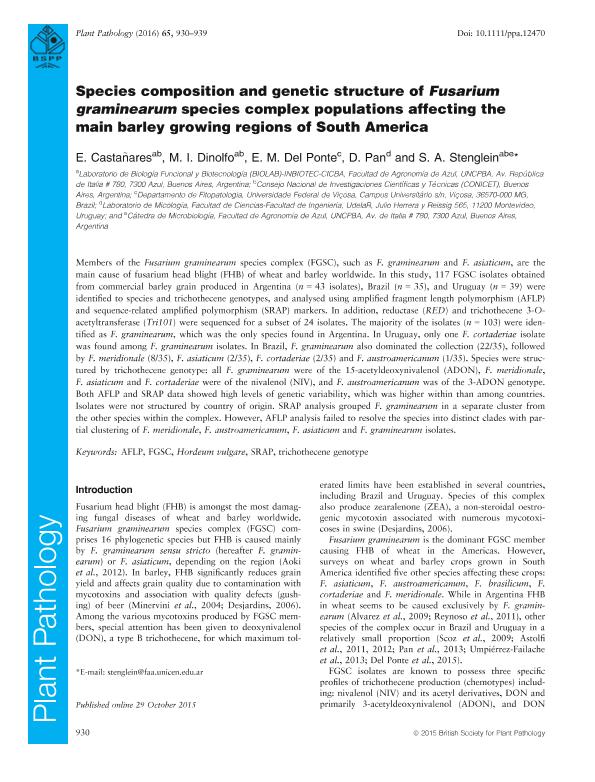Mostrar el registro sencillo del ítem
dc.contributor.author
Castañares, Eliana

dc.contributor.author
Dinolfo, María Inés

dc.contributor.author
Ponte, E. M. Del
dc.contributor.author
Pan, D.
dc.contributor.author
Stenglein, Sebastian Alberto

dc.coverage.spatial
South America
dc.date.available
2017-09-08T14:31:48Z
dc.date.issued
2016-10-29
dc.identifier.citation
Castañares, Eliana; Dinolfo, María Inés; Ponte, E. M. Del; Pan, D.; Stenglein, Sebastian Alberto; Species composition and genetic structure of Fusarium graminearum species complex populations affecting the main barley growing regions of South America; Wiley Blackwell Publishing, Inc; Plant Pathology; 65; 6; 29-10-2016; 930-930
dc.identifier.issn
0032-0862
dc.identifier.uri
http://hdl.handle.net/11336/23854
dc.description.abstract
Members of the Fusarium graminearum species complex (FGSC), such as F. graminearum and F. asiaticum, are the main cause of fusarium head blight (FHB) of wheat and barley worldwide. In this study, 117 FGSC isolates obtained from commercial barley grain produced in Argentina (n = 43 isolates), Brazil (n = 35), and Uruguay (n = 39) were identified to species and trichothecene genotypes, and analysed using amplified fragment length polymorphism (AFLP) and sequence-related amplified polymorphism (SRAP) markers. In addition, reductase (RED) and trichothecene 3-Oacetyltransferase (Tri101) were sequenced for a subset of 24 isolates. The majority of the isolates (n = 103) were identified as F. graminearum, which was the only species found in Argentina. In Uruguay, only one F. cortaderiae isolate was found among F. graminearum isolates. In Brazil, F. graminearum also dominated the collection (22/35), followed by F. meridionale (8/35), F. asiaticum (2/35), F. cortaderiae (2/35) and F. austroamericanum (1/35). Species were structured by trichothecene genotype: all F. graminearum were of the 15-acetyldeoxynivalenol (ADON), F. meridionale, F. asiaticum and F. cortaderiae were of the nivalenol (NIV), and F. austroamericanum was of the 3 ADON genotype. Both AFLP and SRAP data showed high levels of genetic variability, which was higher within than among countries. Isolates were not structured by country of origin. SRAP analysis grouped F. graminearum in a separate cluster from the other species within the complex. However, AFLP analysis failed to resolve the species into distinct clades with partial clustering of F. meridionale, F. austroamericanum, F. asiaticum and F graminearum isolates.
dc.format
application/pdf
dc.language.iso
eng
dc.publisher
Wiley Blackwell Publishing, Inc

dc.rights
info:eu-repo/semantics/openAccess
dc.rights.uri
https://creativecommons.org/licenses/by-nc-sa/2.5/ar/
dc.subject
Aflp
dc.subject
Srap
dc.subject
Hordeum Vulgare
dc.subject
Fgsc
dc.subject.classification
Otras Agricultura, Silvicultura y Pesca

dc.subject.classification
Agricultura, Silvicultura y Pesca

dc.subject.classification
CIENCIAS AGRÍCOLAS

dc.title
Species composition and genetic structure of Fusarium graminearum species complex populations affecting the main barley growing regions of South America
dc.type
info:eu-repo/semantics/article
dc.type
info:ar-repo/semantics/artículo
dc.type
info:eu-repo/semantics/publishedVersion
dc.date.updated
2017-07-27T12:27:42Z
dc.journal.volume
65
dc.journal.number
6
dc.journal.pagination
930-930
dc.journal.pais
Reino Unido

dc.journal.ciudad
Londres
dc.description.fil
Fil: Castañares, Eliana. Consejo Nacional de Investigaciones Científicas y Técnicas. Centro Cientifico Tecnolológico Mar del Plata. Instituto de Investigaciones en Biodiversidad y Biotecnología. Laboratorio de Biologia Funcional y Biotecnología; Argentina
dc.description.fil
Fil: Dinolfo, María Inés. Consejo Nacional de Investigaciones Científicas y Técnicas. Centro Cientifico Tecnolológico Mar del Plata. Instituto de Investigaciones en Biodiversidad y Biotecnología. Laboratorio de Biologia Funcional y Biotecnología; Argentina
dc.description.fil
Fil: Ponte, E. M. Del. Universidade Federal de Viçosa. Departamento de Fitopatologia; Brasil
dc.description.fil
Fil: Pan, D.. Universidad de la República. Facultad de Ciencias; Uruguay
dc.description.fil
Fil: Stenglein, Sebastian Alberto. Universidad Nacional del Centro de la Provincia de Buenos Aires. Facultad de Agronomia; Argentina. Consejo Nacional de Investigaciones Científicas y Técnicas. Centro Cientifico Tecnolológico Mar del Plata. Instituto de Investigaciones en Biodiversidad y Biotecnología. Laboratorio de Biologia Funcional y Biotecnología; Argentina
dc.journal.title
Plant Pathology

dc.relation.alternativeid
info:eu-repo/semantics/altIdentifier/doi/http://dx.doi.org/10.1111/ppa.12470
dc.relation.alternativeid
info:eu-repo/semantics/altIdentifier/url/http://onlinelibrary.wiley.com/doi/10.1111/ppa.12470/abstract
Archivos asociados
